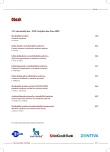-
Medical journals
- Career
Metabolic syndrome and the liver (NAFLD/NASH)
Authors: P. Hůlek 1; I. Dresslerová 2
Authors‘ workplace: II. interní klinika Lékařské fakulty UK a FN Hradec Králové, přednosta prof. MUDr. Jaroslav Malý, CSc. 1; I. interní klinika Lékařské fakulty UK a FN Hradec Králové, přednosta prof. MUDr. Jan Vojáček, CSc. 2
Published in: Vnitř Lék 2009; 55(7-8): 646-649
Category: 134th Internal Medicine Day - 23rd Vanysek's Day Brno 2009 - Vanysek's Lecture
Overview
Metabolic syndrome (MS) is one of the most prevalent disease states in the so-called developed countries and is closely associated with the incidence of cardiovascular as well as other diseases. Predominant sign is the abdominal type of obesity with increased visceral fat mass and the associated insulin resistance. Glucose metabolism disorder, dyslipidemia and arterial hypertension are other important attributes. Metabolic syndrome is also closely associated with the liver steatosis, mostly benign and reversible liver disease. Nevertheless, uncomplicated steatosis may, under certain conditions, progress to inflammation and the disease may, through the stage of NASH (non-alcoholic steatohepatitis) and liver fibrosis, result in liver cirrhosis and hepatocellular carcinoma. Anglo-Saxon literature uses the term NAFLD (non-alcoholic fatty liver disease) to refer to these various stages of the liver disease (uncomplicated liver steatosis, steatohepatitis, fibrosis and cirrhosis). While simple steatosis is not dangerous for the patient, NASH is the sign of developing cirrhosis. Etiopathogenesis of NASH features identical characteristics as etiopathogenesis of insulin resistance and metabolic syndrome. Even though liver biopsy remains the gold standard in the diagnosis, new diagnostic approaches are emerging that could be useful in distinguishing simple steatosis from NASH. Therapy includes lifestyle changes, insulin resistance-reducing medication (also useful in the treatment of type 2 diabetes) with a range of other agents under development. In the meantime, randomized double-blind placebo-controlled studies with histological proof of the results are still lacking. A range of unresolved issues remains with regards to etiopathogenesis as well as diagnosis and treatment of NAFLD and NASH.
Key words:
metabolic syndrome – non-alcoholic steatohepatitis – NAFLD – insulin resistance
Sources
1. Kashi M, Torres D, Harrison S. Current and Emerging Therapies in Nonalcoholic Fatty Liver Disease. Available from http://www.medscape.com/viewarticle/584227?src=top10.
2. Sundaram V, Northup G, Nadkarmi M et al. Metabolic syndrome is a major risk factor for NAFLD among patients with non‑insulin dependent diabetes mellitus. Gastroenterology 2006; 130: A–824.
3. Younossi Z, Baranova A, Ad N et al. Serum adiponectin and resistin in NAFLD and arteriosclerosis. Gastroenterology 2006; 130: A–828.
4. Wieckowska A, Zein N, Yerian L et al. Detection of caspase activity in the blood of patients NAFLD as a novel biomarker of disease severity. Gastroenterology 2006; 130: A–749.
5. Shirin H, Aeed V, Sorin M et al. Utility of 13C-methacetin breath test in the evaluation of the extent of hepatic injury in an animal model. Gastroenterology 2006; 130: A–828.
6. Urita Y, Ishihara S, Arai K et al. [1–13C] – acetate breath test reveals impaired acetate metabolism in patients with fatty liver diseases. Gastroenterology 2006; 130: A–594.
7. Fukuzawa Y, Ohashi T, Matsumati E et al. Efficacy of non‑invasive hepatic fibrosis quantification by liver elasticity measurement in nonalcoholic steatohepatitis (NASH) – comparison of ultrasonic transient elastography and histopathological diagnosis. Gastroenterology 2006; 130: A–79.
8. http://www.echosens.com/Expertise/FibroScan.html.
Labels
Diabetology Endocrinology Internal medicine
Article was published inInternal Medicine

2009 Issue 7-8-
All articles in this issue
- Treatment of hypertension in metabolic syndrome
- Treatment of diabetes in metabolic syndrome
- Metabolic syndrome and the liver (NAFLD/NASH)
- Anxious-depressive disorders and metabolic syndrome
- Metabolic syndrome and cardiovascular disease
- Chronic mild inflammation links obesity, metabolic syndrome, atherosclorosis and diabetes
- Laboratory markers of metabolic syndrome in clinical practice
- Treatment of dyslipidemia in patients with metabolic syndrome and chronic kidney disease
- Metabolic syndrome
- Obesity treatment in metabolic syndrome patients
- Lipid-lowering treatment in metabolic syndrome
- Internal Medicine
- Journal archive
- Current issue
- Online only
- About the journal
Most read in this issue- Metabolic syndrome and the liver (NAFLD/NASH)
- Anxious-depressive disorders and metabolic syndrome
- Chronic mild inflammation links obesity, metabolic syndrome, atherosclorosis and diabetes
- Laboratory markers of metabolic syndrome in clinical practice
Login#ADS_BOTTOM_SCRIPTS#Forgotten passwordEnter the email address that you registered with. We will send you instructions on how to set a new password.
- Career

